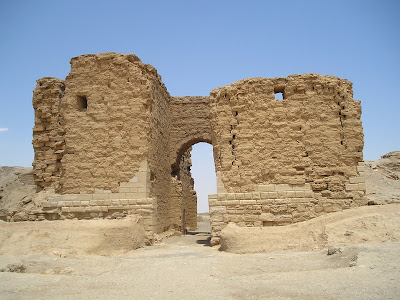Dura Europus
The city
of Dura Europus sitiuated in the syrian
desert close to the river Euphrates, it founded
Originally at the end of the fourth century BC by the Seleucids on the
intersection of an east-west trade route and the trade route along the
Euphrates, the town was occupied by the
Romans in 165 AD. It prospered as a frontier garrison, but fell after a siege
by the Persians in the year 257 and was abandoned.
The
church began as a respectable middle-class home built of unbaked brick on rough stone foundations,
with carved blocks of gypsum set round the doors .The rooms were arranged,
in conventional Asiatic fashion, around
a paved court to which a narrow vestibule gave access. Inside the walls
were covered with thick plaster. An inscription, apparently scratched while the
plaster was still wet, gives the date 232 AD.
The church was originally a house that transformed to a church.The
Christian assembly-room
of this house-church is of very plain
construction. Tow rooms on the south side were combined, by the removal of a wall,
to form one substantial assembly-room, 13.1 meters in length. A low platform on
which the bishop could stand or sit is the only piece of liturgical equipment occupied the short east wall of
this assembly-room. This room would have seated a congregation of fifty or
sixty
At
right angles to the place of assembly was another room half as large. It is
entirely featureless, it served as a school, a place of instruction for the
(catechumens), who were not yet full members of the church,who hear but not see
the Mass of the Faithful, to receive the instruction, and to prepare themselves
for baptism. This room ( 4 by 7 m.) offering space for roughly thirty.
The decoration:
The north wall
displays three examples of the Saviour‘s power. The first of the healing of the
paralysed man. Most examples of this theme, in the compressed, almost shorthand
style of early Christian art, show the ‘ sick of the palsy ‘ walking away with
his bed on his back, thus indicating his cure, while the Healer himself is
either absent from the scene or stands on one side.

محول الاكوادإخفاء الابتساماتإخفاء ركن الاسئلنة